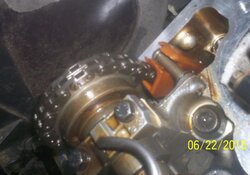Daisywheels
Well-Known Member
- Joined
- July 1, 2014
- Messages
- 271
- Reaction score
- 2
- Year, Model & Trim Level
- 1999 XLT XP SOHC V6
Hi all - Brief history: Rocker/follower came off. No visible damage to any parts so I put in back on with a new lash adjuster. No water in oil prior to this, as I just changed it.
Started truck per Haynes, got it warm, ran at 3000 RPMs for 1 minute then shut it down. I heard what had sounded like the follower did not hold, so I decided to check the oil to see if there was any major damage. Sure enough - water/coolant in oil.
Pulled the valve cover only to find out that the original rocker did hold, and it threw the exhaust rocker right next to where I replaced the intake follower. What luck huh?
Any ways, I was hoping for some suggestions for other things to check before I pull the head. This is just too bizarre to me! I am aware the water does not pass through the intake manifolds, so that's all I will rule out right now.
TIA! -DW
Started truck per Haynes, got it warm, ran at 3000 RPMs for 1 minute then shut it down. I heard what had sounded like the follower did not hold, so I decided to check the oil to see if there was any major damage. Sure enough - water/coolant in oil.
Pulled the valve cover only to find out that the original rocker did hold, and it threw the exhaust rocker right next to where I replaced the intake follower. What luck huh?
Any ways, I was hoping for some suggestions for other things to check before I pull the head. This is just too bizarre to me! I am aware the water does not pass through the intake manifolds, so that's all I will rule out right now.
TIA! -DW













